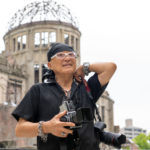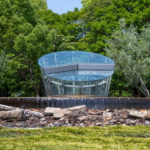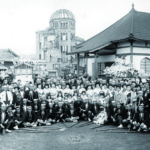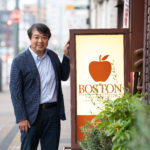column 6 Standing at the Ground Zero: The words of people who have visited Hiroshima
Introduction
Today, around 11.5 million people visit Hiroshima each year, about 530,000 of them come from overseas. The majority of these foreign tourists visit the Peace Memorial Park and the Hiroshima Peace Memorial Museum. The total number of visitors to the Hiroshima Peace Memorial Museum in 2013 was around 1,380,000, with around 200,000 of these people coming from outside the country. What do these people, especially these foreign visitors, feel here? What are their thoughts?
1. Dialogue Notebooks
The people from abroad who set foot in Hiroshima directly after the war were limited to the occupying forces and journalists. Foreign tourism began to increase after the peace treaty came into effect and Japan’s sovereignty was restored in April, 1952. The Peace Memorial Museum opened in August 1955 and attracted over 110,000 visitors in its first year. Since then, the number of visitors has generally continued to increase and the number of visitors per year exceeded one million in the 1970s.
Notebooks are located near the exit of the main building of the Peace Memorial Museum to facilitate a dialogue with visitors or between visitors and the museum. It was first placed there in October of 1970 at the suggestion of the then director, Kaoru Ogura. People of different nationalities and ages have written their thoughts down in their own languages. The number of notebooks has reached 1,323 (as of December, 2014).
2. Messages from speeches and the visitor’s books
Leaders from around the world have also visited Hiroshima and left behind their thoughts in written form. For instance, India’s first prime minister, Jawaharlal Nehru, visited the Peace Memorial Park in October, 1957 and remarked that it was a trip of worship at holy sites, and that Hiroshima was the worst possible result of violence, but also signified hope that regeneration will occur.” A speech given by Pope John Paul II (from Poland) upon visiting Hiroshima in February, 1981, is also impressive. “To remember the past is to commit oneself to the future.” While repeating this phrase, the Pope talked to people, “To remember Hiroshima is to commit oneself to peace. To remember what the people of this city suffered is to renew our faith in man, in his capacity to do what is good, in his freedom to choose what is right, in his determination to turn disaster into a new beginning.” Various national leaders and celebrities have also left messages in the Visitor’s Books at the Peace Memorial Museum (over 2,000 people had written in 66 notebooks, as of August, 2014). For example, an Olympic gold medalist, Florence Griffith Joyner, who represented the U.S. in women’s athletics at the Seoul 1988 Olympic Games, visited the museum in March, 1990 and wrote the following: “I wish in my heart that I could turn back the hands of time and not have let what happened in 1945 happen but I can’t. So I will always pray that our world would learn from that disaster and fight for World Peace. 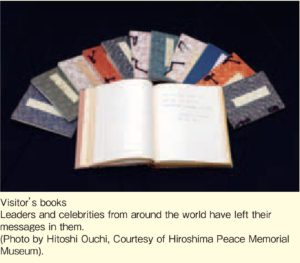 All of the world needs to come here and witness the devastation and always have Peace in their Hearts!” Mikhail Gorbachev, former President of the Soviet Union, visited in April, 1992 and left these words: “The years have not been able to ease the pain of the tragedy in Hiroshima. It shall never be repeated. We will never forget the victims of the atomic bombing.” Bingu Wa Mutharika, President of the Republic of Malawi in Africa wrote in March, 2006, “This memorial park is a sad reminder of human beings destroying themselves through hate. I hope that never again will it make it possible for mankind to engage in such a war. We need peace on Earth. We need love, understanding, tolerance, and forgiveness.” These “Messages for Peace” can be read on the museum website.
All of the world needs to come here and witness the devastation and always have Peace in their Hearts!” Mikhail Gorbachev, former President of the Soviet Union, visited in April, 1992 and left these words: “The years have not been able to ease the pain of the tragedy in Hiroshima. It shall never be repeated. We will never forget the victims of the atomic bombing.” Bingu Wa Mutharika, President of the Republic of Malawi in Africa wrote in March, 2006, “This memorial park is a sad reminder of human beings destroying themselves through hate. I hope that never again will it make it possible for mankind to engage in such a war. We need peace on Earth. We need love, understanding, tolerance, and forgiveness.” These “Messages for Peace” can be read on the museum website.
Conclusion
Naturally, these are only samples of the messages of those who have visited Hiroshima. No doubt each visitor from overseas has in their own way brought their own personal Hiroshima back to their native land. On the other hand, places of tragedy where human life has mercilessly been taken are being recreated even today, 70 years after the atomic bombing. Hiroshima rose from the ashes and was reborn as a city that longs for peace, and so it will continue to bear the historical mission of questioning
“incomplete peace” on earth.
(Hitoshi Nagai)
Inquiries about this page
Hiroshima Prefectural Office
Street address:10-52, Motomachi, Naka-ku, Hiroshima-shi, Hiroshima-ken, 730-8511
Tel:+81-(0)82-228-2111



